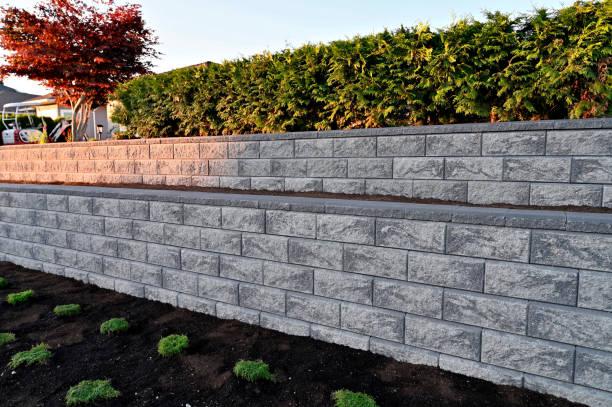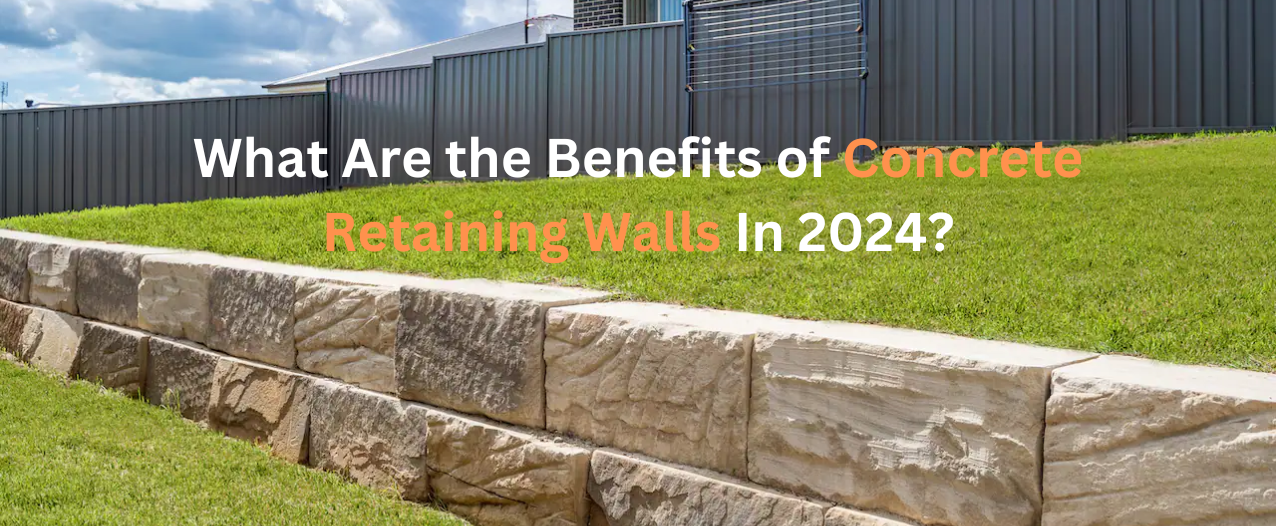Designing OKC Precision Retaining Walls that enhance your outdoor space
Trick Considerations for Structure Efficient Retaining Walls in Your Lawn
When you're thinking about building a retaining wall in your lawn, it's important to think concerning numerous essential factors. The wall surface's objective, the products you'll utilize, and the particular dirt problems can all impact its performance and durability. You'll likewise require to browse local building ordinance and plan for proper water drainage. Exactly how do you assure your design not just fulfills these needs but also enhances your landscape? Let's explore the crucial steps with each other.
Understanding the Function of Your Retaining Wall
When you assume concerning constructing a keeping wall surface, consider its main objective: stabilizing soil and preventing erosion. Retaining walls give vital assistance for sloped landscapes, aiding to maintain soil honesty. You'll discover they're essential in locations where water runoff may or else get rid of soil, bring about pricey repairs and landscape damage.
By holding back planet, these walls develop degree surfaces for gardens, outdoor patios, or paths. This not just improves your backyard's aesthetic appeals however likewise promotes much better drain, reducing water pooling in unwanted areas. If you're managing steep slopes, a well-constructed retaining wall can avoid landslides, making sure safety and security for you and your home.
Eventually, comprehending the function of your retaining wall surface will certainly lead your layout choices and aid you produce a functional, sturdy framework that fulfills your needs. Take a minute to review your landscape; it'll pay off in the long run.
Picking the Right Materials
When choosing products for your retaining wall, you'll wish to take into consideration durability, visual appeals, and price. Each factor plays an essential duty in guaranteeing your wall surface stands the test of time while looking terrific and fitting your budget. Allow's check out how to make the best selections for your task.
Product Sturdiness Elements
Choosing the appropriate materials is crucial for the long life and efficiency of your retaining wall surface, considering that their sturdiness directly affects the wall's ability to withstand ecological tensions. Start by considering your neighborhood climate; products like concrete and rock withstand moisture and temperature level fluctuations well. If you stay in an area vulnerable to heavy rains, choose materials with excellent drainage homes, like crushed rock or porous blocks, to avoid water accumulation.
Additionally, consider the soil problems on your building. Some materials do much better in details dirt kinds, so it's crucial to match them as necessary. Be mindful of possible wear from insects or erosion. Picking durable materials warranties your retaining wall stands strong, shielding your yard for years to find.
Visual Style Choices
Resilient materials not just assure your retaining wall surface's structural honesty yet likewise play a vital role in its visual allure. When choosing the right products, think of how they match your landscape. All-natural rock offers a timeless, rustic appearance, while cinder block can provide a sleek, modern-day coating. You could also think about utilizing wood for a cozy, natural feeling. Color and structure matter, too; pick tones that harmonize with your home and garden. Don't forget concerning the wall surface's form-- rounded walls can develop a softer look, while straight lines can really feel extra organized. By meticulously choosing materials that align with your visual vision, you'll improve your exterior area while ensuring your wall surface stands solid against the elements.
Cost-Effectiveness Analysis
Selecting the best products for your retaining wall surface isn't simply about visual appeals; it's likewise essential for your budget. When selecting products, take into consideration both upfront expenses and lasting resilience.
Do not neglect to factor in maintenance costs. Some materials, like natural stone, can add elegance and require less upkeep, while others might need regular treatments
Eventually, weigh the benefits and drawbacks of each alternative versus your spending plan and the wall surface's desired objective. Spending intelligently in materials now can avoid costly issues down the road. Choose products that stabilize cost and performance effectively.
Assessing Soil Problems and Water Drainage
As you start your task, assessing soil conditions and drainage is essential for the success of your retaining wall surface. Beginning by checking out the sort of soil in your yard. Sandy soil drains well but lacks stability, while clay dirt can keep dampness, leading to push on your wall surface. Examine the soil's wetness content by digging a tiny opening and observing exactly how rapidly it dries out.
Following, evaluate the slope of your backyard. If water normally streams toward your wall surface, you'll need to apply a drain solution to prevent disintegration and pressure build-up. Think about installing perforated pipelines or crushed rock backfill behind the wall surface to promote drain.
Last but not least, observe any type of neighboring trees or plants; their origins can affect dirt stability. By recognizing your soil problems and implementing appropriate drainage, you'll produce a solid structure for your retaining wall surface that stands the test of time.
Abiding With Local Structure Codes
Before you begin developing your retaining wall surface, you need to research local guidelines to assure conformity. It's vital to comprehend what allows you have to acquire, as this can save you from expensive fines or having to redesign your work. Taking these steps seriously will assist you build a risk-free and reliable structure.
Research Local Laws
Recognizing local policies is crucial when planning your retaining wall surface project, specifically considering that building codes can vary greatly by place. Begin by consulting your neighborhood building department or municipality to find out about specific needs. Search for standards on wall surface height, products, drain systems, and architectural integrity. Numerous locations have constraints on the types of products you can use and just how high you can develop. You'll likewise wish to think about the zoning regulations that may affect your job. Overlooking these guidelines can result in expensive penalties or the need to renovate your work. By doing your study upfront, you can assure your retaining wall surface meets all required codes and blends effortlessly right into Check Out Your URL your backyard.
Acquire Necessary Licenses
Once you have actually looked into regional regulations, the next action is to obtain the needed authorizations for your retaining wall task. This procedure assurances your wall abides by building regulations and safety and security requirements. Get to out to your regional building authority to figure out what allows you require. They might need certain plans or design assessments, specifically for bigger walls. Be prepared to send thorough drawings, including dimensions and products. Don't neglect to check if your task affects drain or bordering homes, as these variables might need extra authorizations. Safeguarding the right approvals can save you from expensive fines or needing to dismantle your wall later. Keep in mind, complying with the policies currently will certainly lead to a smoother construction experience.

Planning the Design and Appearance
As you commence planning the layout and appearances of your retaining wall surface, think about how it will certainly integrate with the surrounding landscape. Think of the products you'll utilize-- stone, block, or concrete-- and exactly how they'll complement your home's style and the all-natural elements in your yard. Pick shades and textures that mix effortlessly with existing features like patio areas, pathways, or yards.
Following, imagine the wall's form and height. Bent walls can soften a rigid landscape, while straight lines might communicate an extra modern-day look. Do not fail to remember to incorporate plants and plant around the wall for an all-natural touch; this can enhance its charm and incorporate it right into the atmosphere.
Finally, bear in mind capability. Your layout must not just be aesthetically pleasing however additionally serve its objective properly. By attentively intending these elements, you'll develop a preserving wall surface that improves your backyard's charm while fulfilling its architectural duty.
Determining Height and Density Needs
To develop a sturdy retaining wall, you require to properly calculate its elevation and thickness needs based on the soil problems and the elevation of the slope it will certainly support. Beginning by assessing the slope's angle and the kind of soil, as various soils apply differing amounts of pressure.
For walls over four feet high, take into consideration a thickness of at the very least 12 inches. If the wall is taller, enhance the density proportionally to keep stability.
Next, determine the height of the wall surface by gauging the upright range it needs to maintain. For every single foot of elevation, you should commonly plan for a thickness of one-third of the wall's elevation.
Constantly bear in mind to represent additional factors like drainage and backfill, which can affect your wall surface's design. Appropriate computations now ensure your retaining wall stands strong and lasts for many years to find.
Maintenance and Long Life Factors To Consider
While keeping your retaining wall surface may feel like a low concern, overlooking Find Out More it can lead to considerable problems in time. Regular evaluations are vital; check for cracks, bulges, or any signs of water damage. Addressing these problems early can conserve you from expensive repair services down the road.
Watch on drainage systems, also. Obstructed drains pipes can cause water to build up, exerting stress on your wall and compromising its security. Clear particles and guarantee correct flow to preserve durability.
You might additionally wish to review sealing your wall to secure it from wetness and weathering. Depending upon the product, this could need reapplication every couple of years.
Last but not least, landscaping around your go to this web-site wall can support its stability. Stay clear of growing huge trees close by, as their origins can weaken the structure. With positive maintenance, your retaining wall surface can serve you well for years to find.

Regularly Asked Questions
Can I Build a Retaining Wall by Myself, or Should I Employ a Professional?
You can most definitely build a retaining wall on your own if you have the right devices and understanding. Nevertheless, hiring a professional warranties it's done correctly, particularly for larger or more complex frameworks. Consider your ability level before making a decision.
What Are one of the most Usual Errors Made When Structure Retaining Walls?
When constructing retaining walls, you might neglect appropriate drain, miss using the right products, or disregard support. These usual blunders can lead to structural failure, so take your time and plan very carefully to stay clear of problems.
Just how Do I Know if My Retaining Wall Needs Reinforcement?
You'll know your retaining wall needs reinforcement if you notice cracks, leaning, or bulging. Look for water pooling behind it or soil erosion near the base. Address these indicators quickly to avoid additional damage.
What Plants Are Appropriate for Landscaping Around a Retaining Wall?
When landscaping around a keeping wall, think about using low-maintenance plants like succulents, ornamental grasses, or creeping ground covers - OKC Precision Retaining Walls. They'll thrive in those problems and add charm while avoiding soil erosion around your wall surface
Just How Can I Stop Erosion Around My Retaining Wall?
To avoid erosion around your retaining wall surface, you can grow ground cover, usage compost, and mount drain systems. Regularly look for water build-up and change landscaping to reroute drainage far from the wall surface.